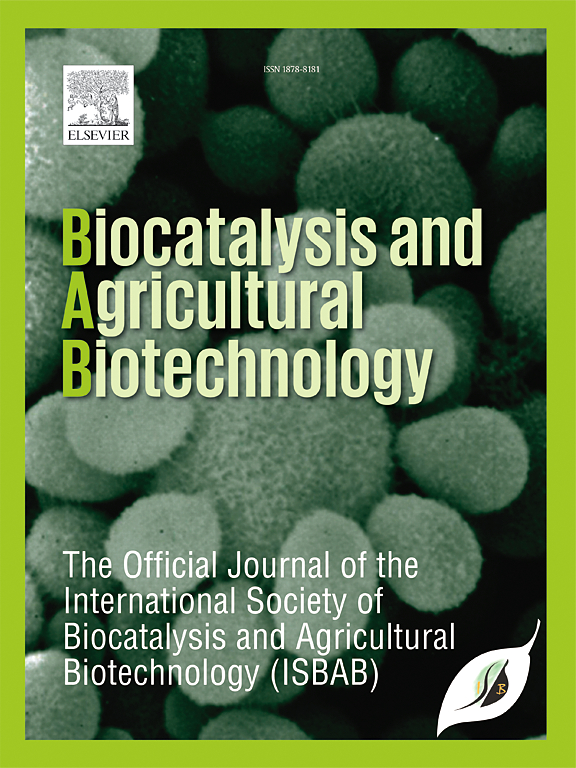利用黑僵菌生态降解甲基橙
IF 3.8
Q2 BIOTECHNOLOGY & APPLIED MICROBIOLOGY
引用次数: 0
摘要
染料污染问题广泛存在,甲基橙(MO)等危险化学品污染水源,对环境和人类健康构成重大威胁。本研究探索了一种有前途的环保解决方案:利用皮氏Ralstonia pickettii细菌生物降解MO。结果表明,在静态条件下,皮氏霉对MO (100 ~ 200 mg/L)的脱色率为98%。脱色的最佳条件为pH = 7,温度为40℃。当培养基中含有乳糖肉汤、硫酸铵、尿素、酵母提取物和明胶等底物时,MO的脱色效果最大。培养物在48小时内表现出显著的脱色能力。漆酶、NADH-DCIP还原酶和偶氮还原酶等酶的活性表明它们参与了MO结构的分解。利用FTIR和LC-TOF/MS对脱色后形成的代谢物N, N-二甲基苯胺(m/z 121)、4-氨基-2,6-二羟基苯甲酸酯(m/z 169)和(2Z,4E)-5-氨基-2,5-二羟基戊酸酯(m/z 144)进行了表征。植物毒性试验表明,MO对绿豆有毒性,脱色后得到的代谢物对绿豆无毒。本文章由计算机程序翻译,如有差异,请以英文原文为准。
Eco-friendly degradation of methyl orange using Ralstonia pickettii
The widespread problem of dye pollution, with hazardous chemicals like methyl orange (MO) contaminating water sources, poses a significant threat to both the environment and human health. This study explored a promising and environmentally friendly solution: biodegradation of MO using the bacterium Ralstonia pickettii. The results demonstrated that R. pickettii effectively decolorized MO (100–200 mg/L) by 98 % under static conditions. The optimal conditions for decolorization were found to be a pH of 7 and a temperature of 40 °C. The decolorization of MO was maximized when the growth medium contained substrates like lactose broth, ammonium sulfate, urea, yeast extract, and gelatin. The culture exhibited significant decolorization capacity for 48 h. The activities of enzymes like laccase, NADH-DCIP reductase, and azoreductase suggest their involvement in breaking down MO structure. Metabolites formed after decolorization, including N, N-dimethylaniline (m/z 121), 4-amino-2,6-dihydroxybenzoate (m/z 169), and (2Z,4E)-5-amino-2,5-dihydroxypenta-2,4-dienoate (m/z 144), were characterized using FTIR and LC-TOF/MS. Phytotoxicity test showed the MO was toxic and metabolites obtained after its decolorization were nontoxic for the mungbean plant.
求助全文
通过发布文献求助,成功后即可免费获取论文全文。
去求助
来源期刊

Biocatalysis and agricultural biotechnology
Agricultural and Biological Sciences-Agronomy and Crop Science
CiteScore
7.70
自引率
2.50%
发文量
308
审稿时长
48 days
期刊介绍:
Biocatalysis and Agricultural Biotechnology is the official journal of the International Society of Biocatalysis and Agricultural Biotechnology (ISBAB). The journal publishes high quality articles especially in the science and technology of biocatalysis, bioprocesses, agricultural biotechnology, biomedical biotechnology, and, if appropriate, from other related areas of biotechnology. The journal will publish peer-reviewed basic and applied research papers, authoritative reviews, and feature articles. The scope of the journal encompasses the research, industrial, and commercial aspects of biotechnology, including the areas of: biocatalysis; bioprocesses; food and agriculture; genetic engineering; molecular biology; healthcare and pharmaceuticals; biofuels; genomics; nanotechnology; environment and biodiversity; and bioremediation.
 求助内容:
求助内容: 应助结果提醒方式:
应助结果提醒方式:


